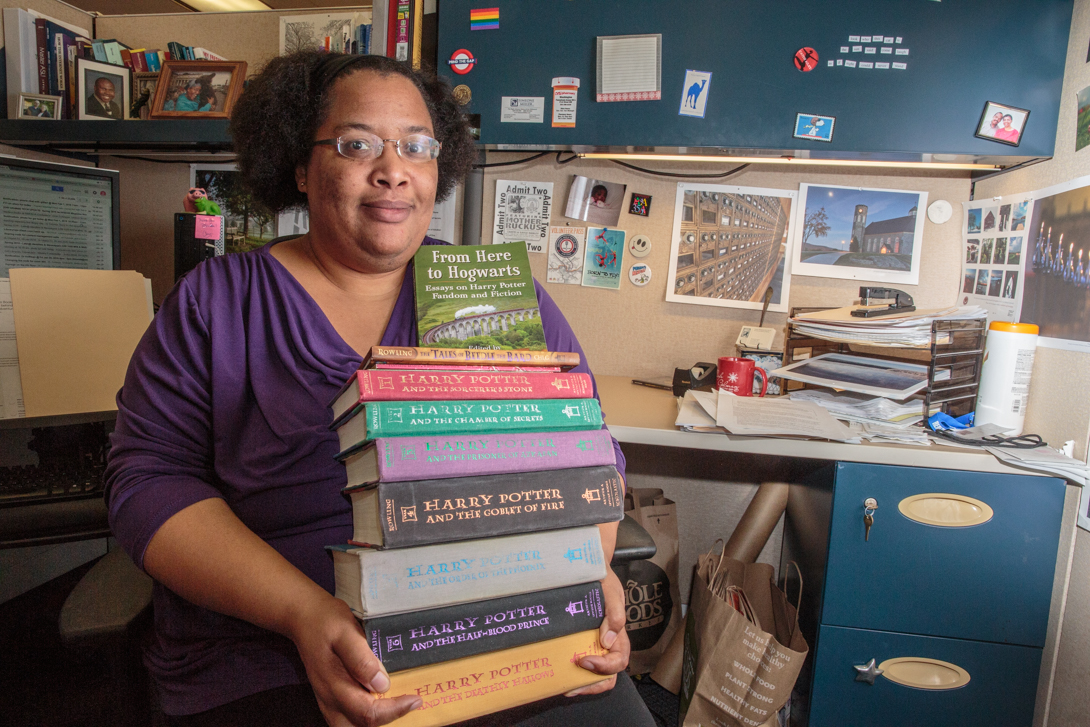In the late ’90s, the story of a boy wizard named Harry Potter fated to save his world from the villainous, power-hungry Voldemort captivated the attention of children and adults worldwide.
George Washington University Instructional Librarian Tolonda Henderson was among the audience that devoured the books written by J.K. Rowling. But unlike many fans, Ms. Henderson wasn’t content to simply immerse herself in the stories. Instead, she took her interest to a scholarly level—writing papers that critically dissect elements of Ms. Rowling’s wizard world.
“I read the books after college, and I loved them, but I was just a regular fan, not even a super-fan,” Ms. Henderson said. “But after completing my second master’s, I was casting around for something new to study, and I found my way to Harry Potter. It felt exciting and fresh and new.”
Her work has earned her a place in the world of “Harry Potter studies,” where a growing crop of academics see value in critiquing the seven-volume saga and its surrounding phenomena, including the eight-part movie series, the fandom and supporting works such as Pottermore and Tales of Beedle the Bard.
Most recently, Ms. Henderson was published in “From Here to Hogwarts: Essays on Harry Potter Fandom and Fiction,” a book of essays collected and edited by Christopher E. Bell, the founding chair of Harry Potter Studies for the Popular Culture Association Southwest/Texas region.
Her essay, “More than Moving Images: The Visual Culture of Harry Potter,” was co-written with Amy M. Von Lintel, assistant professor of art history at West Texas A&M University.
“I met Amy at a conference, and we had this long conversation over dinner that eventually became the outline for the essay,” Ms. Henderson said. “We were just discussing Harry Potter, how pictures come alive, but statues are governed by different rules and what that might mean in the context of artistic theory.”
There is obvious passion when Ms. Henderson discusses the process of breaking down elements of Harry Potter. She credits an initial stint about five years ago assisting a GW University Writing Program professor with a course on Harry Potter for sparking her academic interest.
Since then, Ms. Henderson has led a workshop for GW students, titled “Researching Harry Potter: Or How to Get Credit for your Obsession,” and prides herself on working with students to uncover ways to use Harry Potter in their coursework.
“Typically, it’s not easy to convince professors that an essay on Harry Potter is coming from an academic perspective—right now when you search Harry Potter in our library database there are only 400 results, but the area of study is growing,” Ms. Henderson said.
“And the conversations I’ve had with students about Harry Potter are unexpected and exciting,” she added. “For example, I recently talked with a political communication student about Cornelius Fudge [the Minister of Magic of Britain in Harry Potter], and she was drawing connections to political communication theory.”
Ms. Henderson advises students interested in using the Harry Potter texts as sources to cite carefully when referencing the canon, which she considers to be the seven books. The movies are “alternative canon,” she says, and Ms. Rowling’s comments following the release of the last book about her intentions as a writer are “meta-canon.”
“Yep, meta-canon,” she said grinning. “It’s a term I came up with because if Rowling wanted to say Albus Dumbledore was gay, she should have written it explicitly in the books.”
“Her comments change the meaning of the text, but you can’t completely discount them because she created the world.”
Ms. Henderson has written and presented papers examining the role of the librarian and the library at Hogwarts School of Witchcraft and Wizardry and the lack of scholarly work on Harry’s best friend and companion Ron Weasley. She is also at work on an essay about disability in Harry Potter that examines the “squibs,” those born to at least one wizard parent but have no magical ability.
Ms. Henderson said that she is confident in the future of Harry Potter Studies because the public is still engaging with the work, whether discussing the effect of late actor Alan Rickman on the character Severus Snape or debating Ms. Rowling’s declaration that “white skin was never specified” following the casting of black actress Noma Dumezeni as Hermione Granger in the play “Harry Potter and the Cursed Child.”
“You see this shift, where parents are passing on their love for Harry Potter to their children,” Ms. Henderson said. “Harry Potter isn’t just a set of books, it’s a phenomenon, and it will be interesting to see what that means for future generations of readers.”


